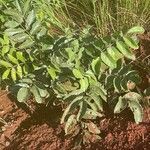Leaves appearing after the flowers, 5–11-foliolate; petiole and rhachis 13–35 cm. long, semicylindric, slightly canaliculate on the upper side, glabrescent; leaflets very discolorous (dark green or ± deep reddish-brown to blackish and glabrescent above, pale fulvous-greyish-tomentose beneath), 2·5–10·5 × 1·5–5·5 cm.., opposite or sub-opposite, oblong-ovate, elliptic or oblong-elliptic, rarely broadly ovate to sub-circular, acute to obtuse or nearly rounded at the apex, the terminal one symmetric, cuneate at the base and with petiolule 1–2·5 cm. long, the lateral ones ± asymmetric at the base and subsessile or with compressed petiolules up to 3 mm. long; midrib, lateral nerves and reticulation somewhat sunk above, slightly prominent below, not so tomentose as the lamina or glabrous and darker than the latter.
Tree up to 15 m. tall with rounded crown and upright bole 10–30 cm. in diam.; bark on bole pale grey, shallowly and irregularly fissured, exfoliating at the base, smooth and grey-purple on the upper branches; floriferous branches ± short, very rugose, ± stellate-tomentose; leafy branchlets, young petioles, rhachis and juvenile leaflets densely grey-or pinkish-to rusty-reddish-tomentose.
Inflorescences generally unbranched, spike-like, 2·5–23 cm. long, rarely with a few short basal branchlets, crowded at the apices of short densely stellate-tomentose branches; flowers with pedicels 1–3·5 mm. long, in dense bundles.
Tree, up to 15 m high. Leaflets with dense tomentum of stellate hairs below, whitish; venation prominent below. Inflorescence spike-like. Drupes reddish to purple, glabrous, compressed. Flowers creamy to bright tawny yellow.
Drupe reddish to purple, 9–15 × 7–10 × 4–5 mm., ovoid to subglobose, compressed.
Calyx-segments ovate, obtuse, glabrous or with a few stellate hairs at the base.
Petals creamy to bright tawny-yellow, 3–5 × 1·3–1·6 mm., oblong.


